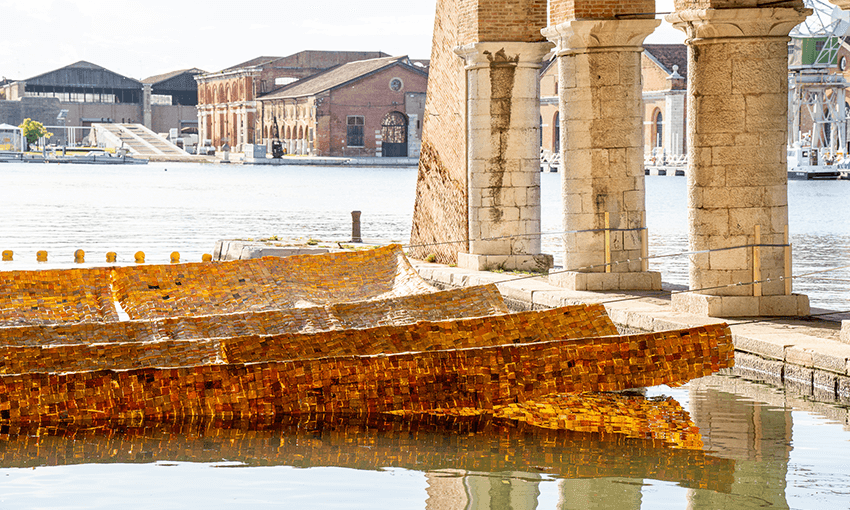This year, Sharon Lam attended the Venice Architecture Biennale. There’s only one thing she knew she wouldn’t see: an entry from Aotearoa. Have we given up on attending these events too easily?
On a Friday morning in the Floating City, two cappuccinos and four cream-centric pasticcinis down, I was flying with my buttcheeks clenched, high on caffeine and the adrenaline from risking such levels of dairy consumption. Destination: the Giardini. After five years of studying and four years of working in the field, my very first Venice Architecture Biennale experience awaited.
Not only was it my first Venice Architecture Biennale, it was also my first Vernissage. “Vernissage,” of course, being French for “varnishing,” a term going back to the salon days where friends and VIPs would watch exhibiting painters varnish their hung works before formally opening to plebians.
I felt special to be one of the privileged fume sniffers until I realised that, as with all exclusive events, there is an even more exclusive event, which in this case was a pre-Vernissage Vernissage. The design It girls and nepo journo boys were already running around Venice whispering sweet terminological nothings to one another – “extraction” this and “entanglement” that – days before I was set to arrive.
This year’s biennale, curated by Ghanaian-Scottish academic, architect, and chick-lit novelist Lesley Lokko, is titled The Laboratory of the Future, heralding a thematic diptych of decarbonisation and decolonisation. This year’s participants are of an equal gender balance, over half are from the African continent and diaspora, and the average age is 43 (a dribbling baby in architect years). This makes 2023 the youngest, most diverse, and least white the Venice Architecture Biennale has ever been.
I had avoided looking at sneak preview photos, I wanted to see everything unspoiled. There was only one thing I knew I definitely wouldn’t see: an entry from Aotearoa.
At first I thought, perhaps we weren’t invited? Unlike countries such as Australia, Japan, and France, New Zealand doesn’t have a permanent pavilion in the Giardini, the historic centre of the Biennale. For the pavilion-less countries, renting and arranging a space takes a bit more admin, and much more intention. Last year, at the art edition of the biennale, New Zealand did contribute and shared a space with Albania in the Arsenale, a long stretch of former armoury buildings. This year, Albania was in the same spot, happily filling up New Zealand’s space of yesteryear with piles of scene-setting gravel.
However, participation in Venice is largely an open invite (except for Russia), and there were no invite-snubbing barriers behind Aotearoa’s absence. To apply to be in it, there are just two prerequisites: government recognition of the entry, and enough money. And there doesn’t seem to be much money going around.
This month, Creative New Zealand (CNZ) axed funding of the Venice Art Biennale for 2024, even though the current funding only amounts to 1% of CNZ’s annual budget. CNZ contributed $455k in 2016, $780k in 2014, and an undisclosed portion of a $1.2 million International Programme fund in 2022. Next year will be the first time in two decades that New Zealand hasn’t had a national entry at the Art Biennale.
Even if CNZ had more cash to go around, the Architecture Biennale does not qualify for CNZ funding due to its architectural rather than artistic categorisation. In 2016, which was New Zealand’s last appearance at the Architecture Biennale, there was an undisclosed amount provided by the Ministry of Business, Innovation & Employment (MBIE), and the rest came from a mix of institutional and corporate sponsors like AUT, the New Zealand Institute of Architects (NZIA) and Resene.
Should the taxpayer cough up for Aotearoa to attend? Neither MBIE nor the NZIA provided any comment on how much the Architecture Biennale cost in previous years. If we use the previous Arts Biennale budgets for rough comparison, we could say that one architectural exhibition at Venice has a public cost of $700k. There is always the question of where public funding for the arts, culture and education should be spent, and education is currently being hit hard. Victoria University alone is facing a $33m deficit, with jobs and courses set to be cut as a result.
That $700k may not be a huge contribution to tertiary-scaled budgets, but that amount of funding could support students through smaller but direct schemes: architecture scholarships, software subsidies, or open-call ventures like the Brick Bay Folly. Arguably, that’s better than sending a select few to galavant around Italy.
But then there is the counter-argument that, since $700k does not go far anyway, spending that money on keeping up appearances internationally may be worth it. It might even attract some of the media’s perpetually faceless, perpetually lucrative, “foreign fee-paying students”. And for local, fee-dodging students, consistent funding would make the Biennale something to aspire to, knowing that there is a seat at the international table. Aotearoa doesn’t have a reputation for architecture like Sweden or Japan, and having nothing to show at what the New Zealand Institute of Architects describes as “the world’s leading architecture event” doesn’t help.
After three aperol-spritzed days of the Biennale, I could no longer read and no longer see the tote bag as anything other than a natural appendage of a human body. To see Africa at the forefront of the event, and to be introduced to, and in awe of, so many was electric: the unmatched brand of Olalekan Jeyifous’ Afrofuturism, Serge Atuukwei Clottey’s self-described “Afrogallonism,” Ibraham Mahama’s salvaged histories, to name a very small few. There were chilling exhibits, like Killing Architects’ unbelievably in-depth study and documentation of Xinjiang internment camps, and there were chill exhibits, like Latvia’s supermarket of Biennales past.
There were also the decolonial heavy-hitters. Brazil (the winner of the Golden Lion, the top prize for national pavilions) spoke earthily about decolonisation, with touch-me dirt surfaces and a film that hovered above footsteps set to forest-laden songs. Canada took an activist approach, using the aesthetics of protest to attract visitors inside, and proposing practical, no-nonsense tactics within: Land Back, mutual aid housing, gentrification tax. Australia took a more enigmatic approach with wordless video and ghostly sculpture, toying with the concept of the many Queenstowns across the world. There is a Queenstown on every continent, and each is a mark of colonial erasure.
It was after experiencing these decolonisation-forward pavilions in a year that was celebrating them, and feeling how each country took time and care to craft such successful expressions of their own dealings with their pasts, that it really cut that Aotearoa wasn’t there to do the same.
When you are a country with the GDP of New Zealand, spending public funds on something as decently wanky as the Venice Architecture Biennale will always be a bit problematic. The benefits, namely niche international clout, are hard to measure; soft cultural diplomacy to an audience of 300,000 at best. Perhaps the local repercussions hurt more: what does it mean to pursue a field in a country that has no representation outside itself?
There is no news yet about whether New Zealand will be in the next Architecture Biennale. There have been examples in the past where countries have banded together to share the costs of exhibiting, like Kazakhstan, Kyrgyzstan, Tajikstan and Uzbekistan in 2013, and the permanent Nordic pavilion is shared by Finland, Norway and Sweden. Would Australia ever share with us? Do we even want to share with them? Could Aotearoa instead share with Fiji, Sāmoa, the Cook Islands?
There have also been instances where a singular, highly ambitious and highly rich individual spearheaded an entire national campaign. Peter Jackson, are you reading this? Would you like to fund some Weta animatronics for Venice? Maybe some human-sized wētā riding in gondolas as a comment on how human apathy and disgust of entomological species is a gateway stance, leading to further apathy towards other humans?
In the report leading up to CNZ’s cancellation of next year’s participation, it is stated that “while Māori artists have represented Aotearoa New Zealand at Venice, Western knowledge, artforms and institutions have historically been promoted and valued more”. This year’s Biennale celebrated the complete reversal of that sentiment. Hopefully this is an irreversible move for all future Biennales, both art and architecture. And even more hopefully, Aotearoa will get to chime in again too.

